By-Plant Prediction of Dry Matter Yields at Various Growth Stages of Maize Plants (Zea mays L.) Using Leaf Greenness Indicator in Climatic Conditions of Poland
Abstract
:1. Introduction
2. Material and Methods
2.1. Experimental Field
2.2. Observations and Measurements
2.3. Statistical Analysis
2.4. Weather and Soil Conditions
3. Results and Discussion
3.1. SPAD Index
3.2. Dry Matter Yield (DMY)
3.3. Dry Matter Yield Prediction
4. Conclusions
Author Contributions
Funding
Institutional Review Board Statement
Informed Consent Statement
Data Availability Statement
Conflicts of Interest
References
- Asibi, A.E.; Chai, Q.; Coulter, J.A. Mechanisms of nitrogen use in maize. Agronomy 2019, 9, 775. [Google Scholar] [CrossRef] [Green Version]
- Rambo, L.; Ma, B.; Xiong, Y.; Ferreira da Silva, P. Leaf canopy optical characteristics as crop-N-status indicators for field nitrogen management in corn. J. Plant Nutr. Soil Sci. 2010, 173, 434–443. [Google Scholar] [CrossRef]
- Zielewicz, W.; Wróbel, B. Effect of differential nitrogen fertilization on the nutritive value of fodder mallow (Malva verticillata L.) and maize (Zea mays L.) Eurostar variety. J. Res. Appl. Agric. Eng. 2018, 63, 151–156. [Google Scholar]
- Szulc, P.; Bocianowski, J.; Rybus-Zając, M. Response of nitrogen nutritional indices maize leaves to different mineral-organic fertilization. Maydica 2012, 57, 260–265. [Google Scholar]
- Szulc, P.; Waligóra, H.; Michalski, T.; Bocianowski, J.; Rybus-Zając, M.; Wilczewska, W. The size of the Nmin soil pool as a factor impacting nitrogen utilization efficiency in maize (Zea mays L.). Pak. J. Bot. 2018, 50, 189–198. [Google Scholar]
- Gastal, F.; Lemaire, G. Nitrogen uptake and distribution in crops: An agronomical and ecophysiological perspective. J. Exp. Bot. 2002, 53, 789–799. [Google Scholar] [CrossRef] [Green Version]
- Księżak, J.; Bojarszczuk, J.; Staniak, M. Produkcyjność kukurydzy i sorga w zależności od poziomu nawożenia azotem. Polish J. Agron. 2012, 8, 20–28. [Google Scholar]
- Yang, Y.; Timlin, D.J.; Fleisher, D.H.; Lokhande, S.B.; Chun, J.A.; Kim, S.H.; Staver, K.; Reddy, V.R. Nitrogen concentration and dry-matter accumulation in maize crop: Assessing maize nitrogen status with allometric function and a chlorophyll meter. Commun. Soil Sci. Plant Anal. 2012, 43, 1563–1575. [Google Scholar] [CrossRef]
- Niu, J.; Chen, F.J.; Mi, G.H.; Li, C.J. Transpiration and nitrogen uptake and flow in two maize (Zea mays L.) inbred lines as affected by nitrogen supply. Ann. Bot. 2007, 99, 153–160. [Google Scholar] [CrossRef] [Green Version]
- Argenta, G.; Regis Ferreira da Silva, P.; Sangoi, L. Leaf relative chlorophyll content as an indicator to predict nitrogen fertilization in maize. Ciénc. Rural. 2004, 34, 1379–1387. [Google Scholar] [CrossRef] [Green Version]
- Gáborčik, N.; Zmetáková, Z. Chlorophyll (SPAD readings) and nitrogen concentrations in leaves of some forage grasses and legumes. Grassld. Sci. Pol. 2001, 4, 43–48. [Google Scholar]
- Shah, S.H. Houborg, R. McCabe, M.F. Response of chlorophyll, carotenoid and SPAD-502 measurement to salinity and nutrient stress in wheat (Triticum aestivum L.). Agronomy 2017, 7, 61. [Google Scholar] [CrossRef] [Green Version]
- Yuan, Z.; Ata-Ul-Karim, S.T.; Cao, Q.; Lu, Z.; Cao, W.; Zhu, Y.; Liu, X. Indicators for diagnosing nitrogen status of rice based on chlorophyll meter readings. Field Crops Res. 2016, 185, 12–20. [Google Scholar] [CrossRef]
- Zhao, B.; Liu, Z.; Ata-Ul-Karim, S.T.; Xiao, J.; Liu, Z.; Qi, A.; Ning, D.; Nan, J.; Duan, A. Rapid and nondestructive estimation of the nitrogen nutrition index in winter barley using chlorophyll measurements. Field Crops Res. 2016, 185, 59–68. [Google Scholar] [CrossRef]
- Machul, M. Zastosowanie testu SPAD do ustalenia uzupełniającej dawki azotu dla kukurydzy. Pam. Puł. 2005, 140, 159–172. [Google Scholar]
- Uddling, J.; Gelang-Alfredsson, J.; Piikki, K.; Pleijel, H. Evaluation of the relationship between leaf chlorophyll concentration and SPAD-502 chlorophyll meter readings. Photosynth. Res. 2007, 91, 37–46. [Google Scholar] [CrossRef]
- Hoel, B.O.; Solhaug, K.A. Effect of irradiance on chlorophyll estimation with the Minolta SPAD-502 Leaf Chlorophyll Meter. Ann. Bot. 1998, 82, 389–392. [Google Scholar] [CrossRef] [Green Version]
- Ziadi, N.; Brassard, M.; Bélanger, G.; Claessens, A.; Tremblay, N.; Cambouris, A.N.; Nolin, M.C.; Parent, L.É. Chlorophyll measurements and nitrogen nutrition index for the evaluation of corn nitrogen status. Agron. J. 2008, 100, 1264–1273. [Google Scholar] [CrossRef]
- Ata-Ul-Karim, S.T.; Liu, X.; Lu, Z.; Yuan, Z.; Zhu, Y.; Cao, W. In-season estimation of rice grain yield using critical nitrogen dilution curve. Field Crops Res. 2016, 195, 1–8. [Google Scholar] [CrossRef]
- Kozłowski, S.; Goliński, P.; Golińska, B. Barwniki chlorofilowe jako wskaźniki wartości użytkowej gatunków i odmian traw. Zesz. Probl. Post. Nauk Rol. 2001, 474, 215–223. [Google Scholar]
- Zielewicz, W.; Kozłowski, S. Żywotność Sorghum saccharatum (L.) Pers. w aspekcie możliwości jego uprawy w Polsce. Fragm. Flor. Geobot. Pol. Suppl. 2007, 9, 173–181. [Google Scholar]
- Subedi, K.; Ma, B. Nitrogen uptake and partitioning in stay-green and leafy maize hybrids. Crop Sci. 2005, 45, 740–747. [Google Scholar] [CrossRef]
- Szulc, P. The effect of the sum of absolute values of nutrient status indexes in plants of two hybrid types of maize (Zea mays L.) on dynamics of dry matter accumulation in initial vegetation period at varied soil nitrogen and magnesium resources. Fres. Envi. Bullet. 2013, 22, 2616–2624. [Google Scholar]
- IUSS Working Group WRB. World Reference Base for Soil Resources 2014, Update 2015 International Soil Classification System for Naming Soils and Creating Legends for Soil Maps, World Soil Resources Reports No. 106; FAO: Rome, Italy, 2015. [Google Scholar]
- Natywa, M.; Pociejowska, M.; Majchrzak, L.; Pudełko, K. Influence of irrigation and nitrogen fertilization on field and leaf greenness index (SPAD) of maize. Acta Sci. Pol. Agric. 2014, 13, 39–50. [Google Scholar]
- Sulewska, H.; Szymańska, G.; Śmiatacz, K.; Koziara, W.; Niewiadomska, A. Efekty stosowania PRP SOL w kukurydzy uprawianej na ziarno. J. Res. Appl. Agric. Eng. 2013, 58, 161–166. [Google Scholar]
- Piechota, T.; Kowalski, M.; Sawinska, Z.; Majchrzak, L. Ocena przydatności pasowej uprawy roli do doglebowej aplikacji płynnych nawozów organicznych w uprawie kukurydzy. Fragm. Agron. 2014, 31, 74–82. [Google Scholar]
- Costa, C.; Dwyer, L.M.; Dutilleul, P.; Stewart, D.W.; Ma, B.L.; Smith, D.L. Inter-relationships of applied nitrogen, SPAD and field of leafy and non-leafy maize genotypes. J. Plant Nutr. 2001, 24, 1173–1194. [Google Scholar] [CrossRef]
- Machul, M.; Borowiecki, J. Wpływ nawożenia azotem na wielkość i jakość plonu kukurydzy uprawianej na kiszonkę z kolb (CCM). Pam. Puł. 2000, 121, 117–125. [Google Scholar]
- Machul, M.; Jadczyszyn, T. Przydatność wskaźnika względnej zawartości chlorofilu do oceny stanu odżywienia kukurydzy azotem. Pam. Puł. 2005, 140, 173–185. [Google Scholar]
- Rostami, M.; Koocheki, A.R.; Mahallati, M.N.; Kafi, M. Evaluation of chlorophyll mater (SPAD) data for prediction of nitrogen status in corn (Zea mays L.). Am.-Eurasian J. Agric. Environ. Sci. 2008, 3, 79–85. [Google Scholar]
- Hirel, B.; Tétu, T.; Lea, P.J.; Dubois, F. Improving nitrogen use efficiency in crops for sustainable agriculture. Sustainability 2011, 3, 1452–1485. [Google Scholar] [CrossRef]
- Cañas, R.A.; Amiour, N.; Quillerè, I.; Hirel, B. An integrated statistical analysis of the genetic variability of nitrogen metabolism in the ear of three maize inbred lines (Zea mays L.). J. Exp. BVot. 2010, 62, 2309–2318. [Google Scholar] [CrossRef] [PubMed]
- Hokmalipour, S.; Darbandi, M.H. Effects of nitrogen fertilizer on chlorophyll content and other leaf indicate in three cultivars of maize (Zea mays L.). World Appl. Sci. J. 2011, 15, 1780–1785. [Google Scholar]
- Szulc, P.; Waligóra, H. Response of maize hybrid (Zea mays L.), stay-green type to fertilization with nitrogen, sulphur and magnesium. Part II. Plant development and the uptake of mineral components. Acta Sci. Pol. Agric. 2010, 9, 41–54. [Google Scholar]
- Szulc, P. Response of maize hybrid (Zea mays L.), stay-green type to fertilization with nitrogen, sulphur and magnesium. Part I. Yields and chemical composition. Acta Sci. Pol. Agric. 2010, 9, 29–40. [Google Scholar]
- Schepers, J.S.; Francis, D.D.; Vigil, M.; Below, F.E. Comparison of corn leaf nitrogen concentration and chlorophyll meter readings. Commun. Soil Sci. Plant Anal. 1992, 23, 2173–2187. [Google Scholar] [CrossRef]
- Dwyer, L.M.; Anderson, A.M.; Ma, B.L.; Stewart, D.W.; Tollenar, M.; Gregorich, E. Quantifying the nonlinearity in chlorophyll content meter response to corn leaf nitrogen concentration. Can. J. Plant Sci. 1995, 75, 179–182. [Google Scholar] [CrossRef]
- Varvel, G.E.; Schepers, J.S.; Francis, D.D. Ability for in-season correction of nitrogen deficiency in corn using chlorophyll meters. Soil Sci. Soc. Am. J. 1997, 61, 1233–1239. [Google Scholar] [CrossRef]
- Podleśna, A.; Podleśny, J.; Klikocka, H. Effect of fertilization with sulfur and nitrogen on nitrogen-phosphorus management of maize. Przemysł Chem. 2017, 96, 1374–1377. [Google Scholar]
- Sowiński, J.; Liszka-Podkowa, A. Wielkość i jakość plonu suchej masy kukurydzy (Zea mays L.) oraz sorga cukrowego (Sorghum bicolor (L.) Moench.) na glebie lekkiej w zależności od dawki azotu. Acta Sci. Pol. Agric. 2008, 7, 105–115. [Google Scholar]
- Fotyma, E. Reakcja roślin uprawy polowej na nawożenie azotem. III. Kukurydza. Fragm. Agron. 1994, 11, 20–35. [Google Scholar]
- Kruczek, A. Efektywność nawożenia azotem kukurydzy uprawianej na ziarno w rejonie Wielkopolski. Rocz. Nauk. Rol. A 1996, 112, 50–66. [Google Scholar]
- Szulc, P.; Ambroży-Deręgowska, K.; Waligóra, H.; Mejza, I.; Grześ, S.; Zielewicz, W.; Wróbel, B. Dry matter yield of maize (Zea mays L.) as an indicator of mineral fertilizer efficiency. Plants 2021, 10, 830. [Google Scholar] [CrossRef]
- Szulc, P.; Bocianowski, J.; Nowosad, K.; Bujak, H.; Zielewicz, W.; Stachowiak, B. Effects of NP Fertilizer Placement Depth by Year Interaction on the Number of Maize (Zea mays L.) Plants after Emergence Using the Additive Main Effects and Multiplicative Interaction Model. Agronomy 2021, 11, 1543. [Google Scholar] [CrossRef]
- Gonet, Z.; Stadejek, H. Wpływ nawożenia azotem i ilości wysiewu na plony kukurydzy uprawianej na zielonkę bezpośrednio do skarmiania. Fragm. Agron. 1990, 7, 30–43. [Google Scholar]
- Bogucka, B.; Szempliński, W.; Wróbel, E. Reakcja kukurydzy ziarnowej na nawożenie azotem w warunkach północno-wschodniej Polski. In Materiały Konferencji Naukowej Problemy Agrotechniki Oraz Wykorzystania Kukurydzy i Sorgo; UP: Poznań, Poland, 2008; pp. 44–46. [Google Scholar]
- Gáborčik, N. The use of a portable chlorophyllmeter for determination of nitrogen status of grasses and herbage yield. Grassld Sci. Eur. 1996, 1, 221–223. [Google Scholar]
- Piekielek, W.P.; Fox, R.H. Use of a chlorophyll meter to predict sidedress nitrogen requirements for maize. Agron. J. 1992, 84, 59–65. [Google Scholar] [CrossRef]
- Wood, C.W.; Reeves, D.W.; Duffield, R.R.; Edmisten, K.L. Field chlorophyll measurements for evaluation of corn nitrogen status. J. Plant Nutr. 1992, 15, 487–500. [Google Scholar] [CrossRef]
- Vetsch, J.A.; Randall, G.W. Corn production as affected by nitrogen application timing and tillage. Agron. J. 2004, 96, 502–509. [Google Scholar] [CrossRef] [Green Version]
- Blackmer, T.M.; Schepers, J.S.; Vigil, M.F. Chlorophyll meter readings in maize as affected by plant spacing. Commun. Soil Sci. Plant Anal. 1993, 24, 2507–2516. [Google Scholar] [CrossRef]
- Bencze, G. Examination of yield, leaf area and relative chlorophyll content, in monoculture long-term experiment of maize in 2016–2018. Res. J. Agric. Sci. 2019, 51, 174–181. [Google Scholar]
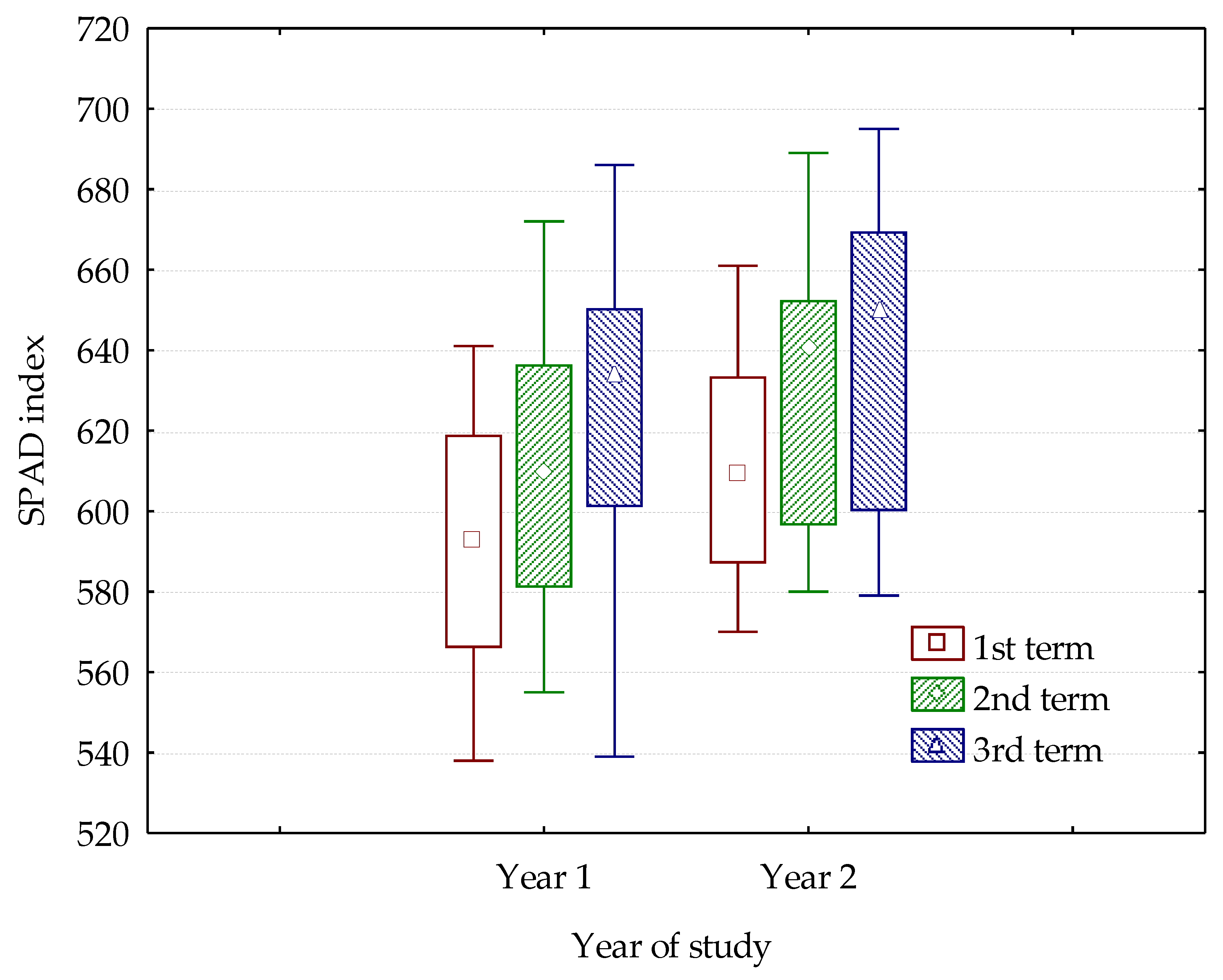
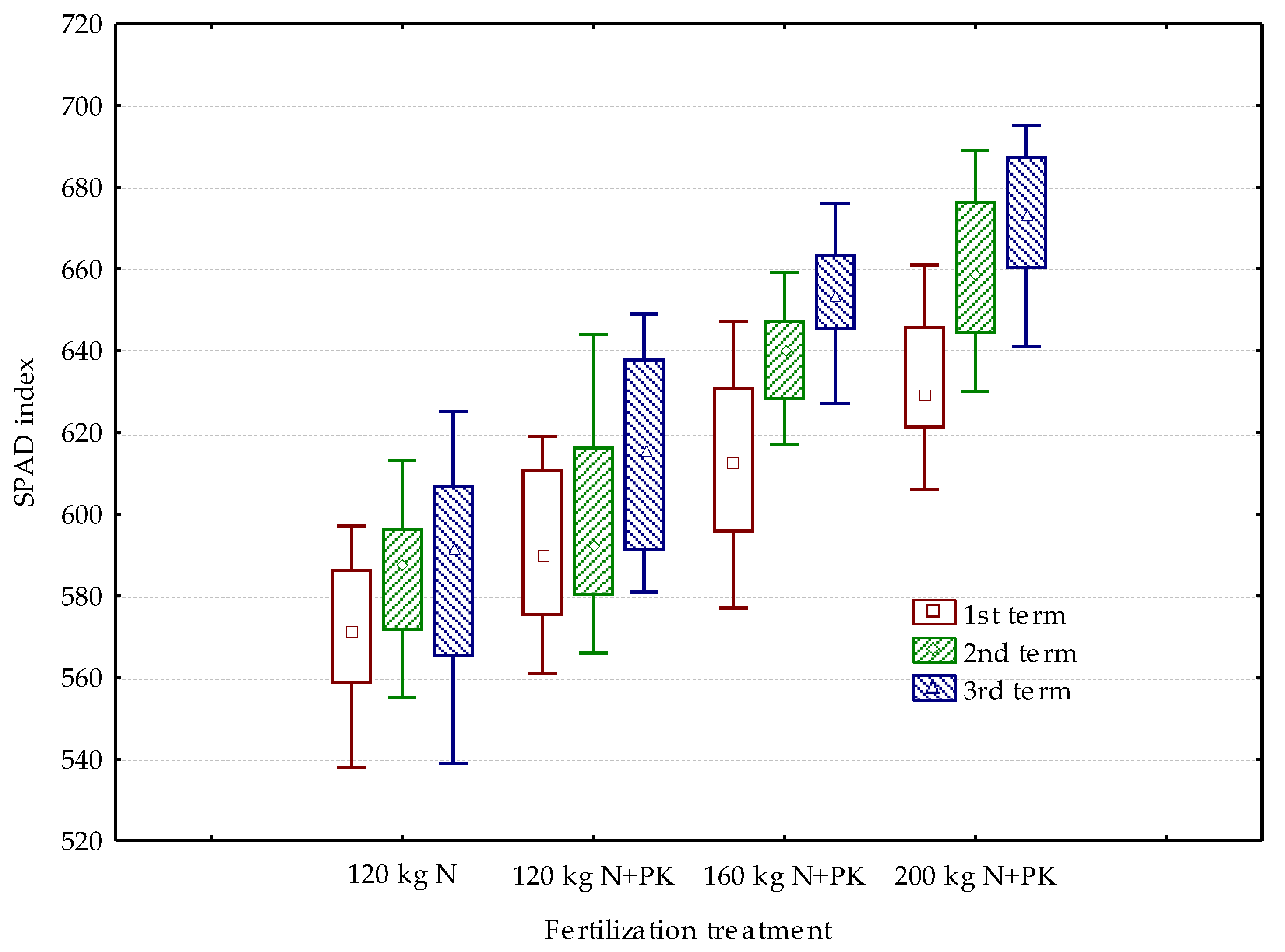
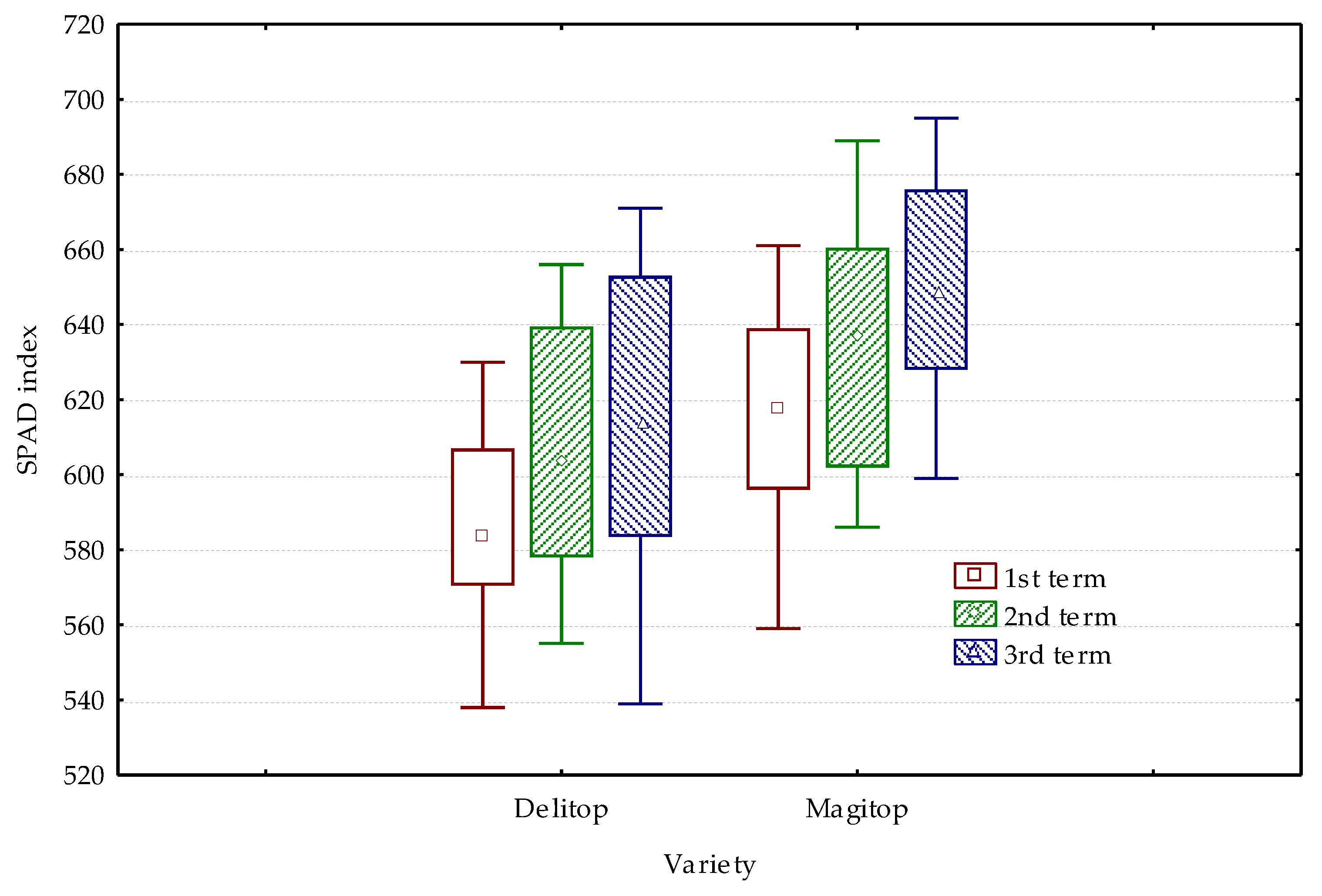
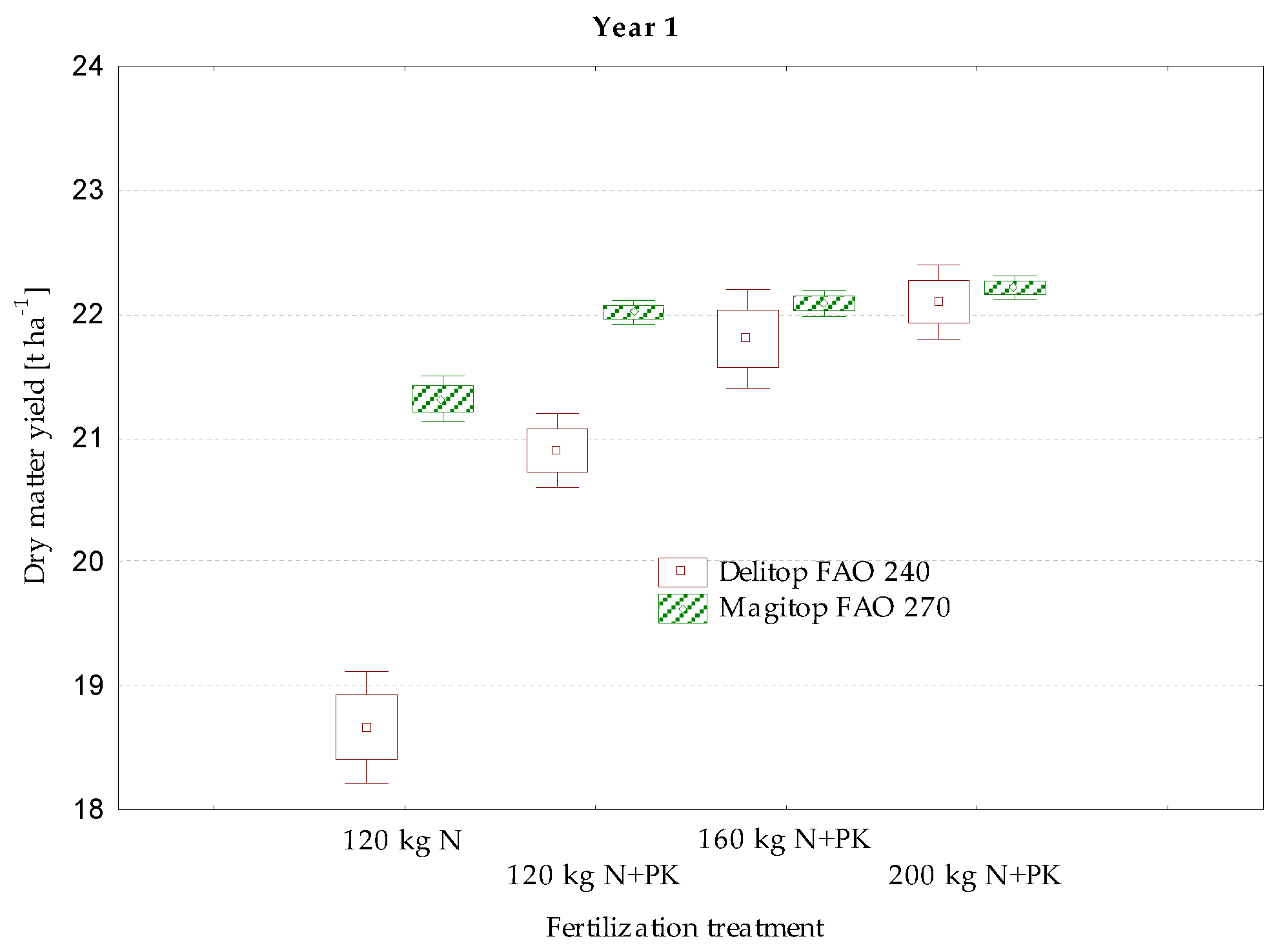
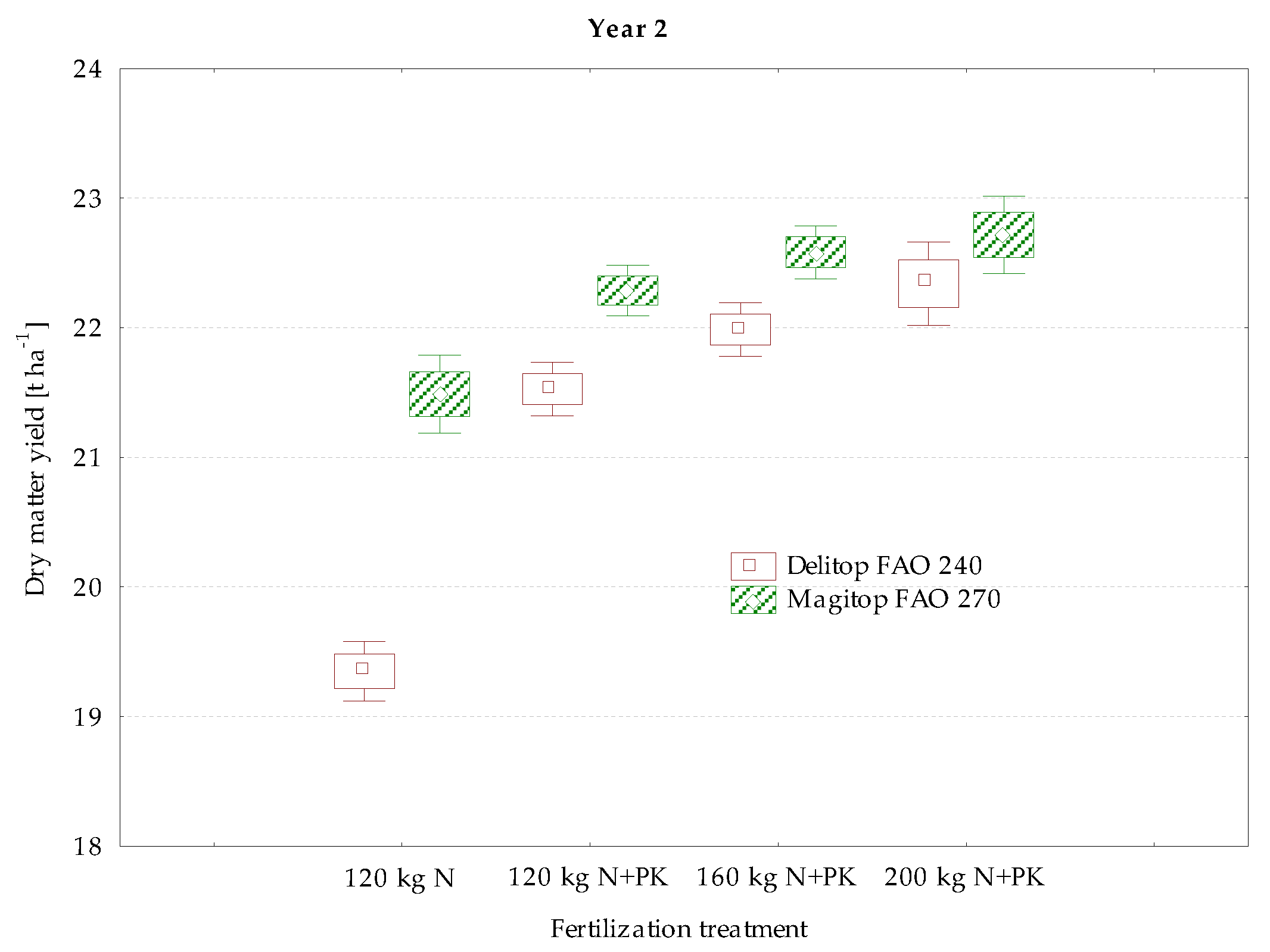
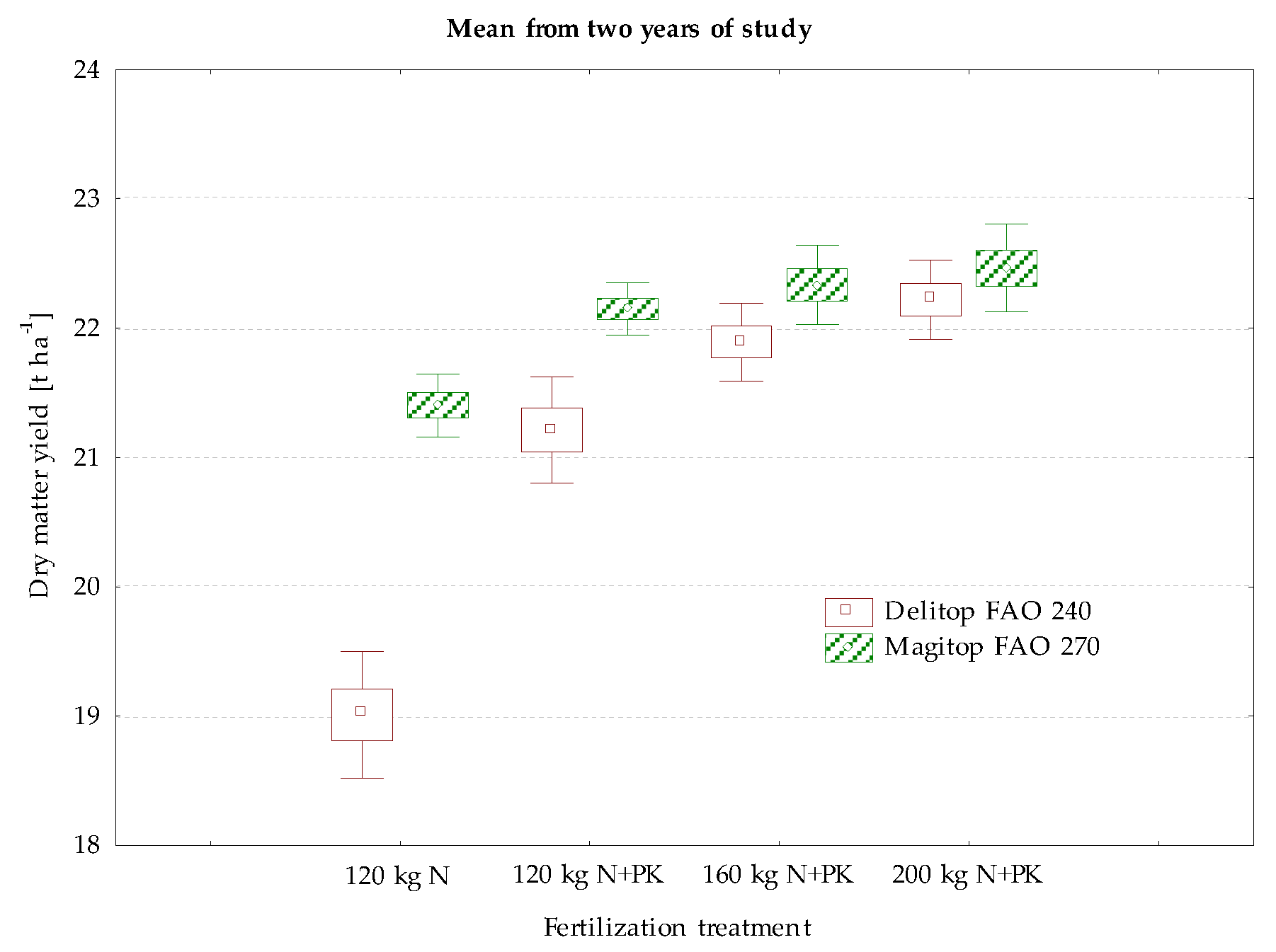
| Month | Average Air Temperature (°C) | Total Rainfall (mm) | ||||
|---|---|---|---|---|---|---|
| The First Year | The Second Year | Long-Term Average | The First Year | The Second Year | Long-Term Average | |
| March | 4.2 | 4.3 | 2.8 | 75.7 | 65.1 | 37.5 |
| April | 8.7 | 11.7 | 7.7 | 8.7 | 13.3 | 37.2 |
| May | 15.2 | 13.4 | 13.1 | 19.5 | 85.3 | 54.7 |
| June | 19.1 | 15.7 | 16.3 | 8.6 | 79.3 | 64.6 |
| July | 20.0 | 19.7 | 17.9 | 80.1 | 68.1 | 77.5 |
| August | 18.8 | 19.7 | 17.4 | 171.5 | 31.4 | 62.7 |
| September | 13.9 | 15.6 | 13.0 | 29.8 | 50.0 | 47.0 |
| October | 10.0 | 7.9 | 8.5 | 74.9 | 73.3 | 40.7 |
| November | 5.7 | 6.7 | 3.4 | 34.3 | 45.4 | 44.1 |
| Mean/Sum March–November | 12.8 | 12.7 | 11.1 | 503.1 | 511.2 | 466.0 |
| Fertilization Variant | Variety Delitop FAO 240 | Variety Magitop FAO 270 | ||||||
|---|---|---|---|---|---|---|---|---|
| 1st Date | 2nd Date | 3rd Date | Mean | 1st Date | 2nd Date | 3rd Date | Mean | |
| 120 kg N·ha−1 | 548 | 559 | 545 | 550 | 566 | 589 | 618 | 591 |
| 120 kg N·ha−1 + PK | 566 | 571 | 586 | 574 | 603 | 598 | 634 | 611 |
| 160 kg N·ha−1 + PK | 584 | 621 | 634 | 613 | 621 | 638 | 652 | 637 |
| 200 kg N·ha−1 + PK | 615 | 635 | 648 | 632 | 634 | 667 | 681 | 660 |
| LSD0.05 | 6.268 | 1.413 | 2.706 | x | 4.828 | 5.827 | 5.413 | x |
| Mean | 578 | 596 | 603 | 592 | 606 | 623 | 646 | 624 |
| Fertilization Variant | Variety Delitop FAO 240 | Variety Magitop FAO 270 | ||||||
|---|---|---|---|---|---|---|---|---|
| 1st Date | 2nd Date | 3rd Date | Mean | 1st Date | 2nd Date | 3rd Date | Mean | |
| 120 kg N·ha−1 | 577 | 586 | 582 | 581 | 593 | 607 | 601 | 600 |
| 120 kg N·ha−1 + PK | 582 | 588 | 596 | 588 | 615 | 637 | 644 | 632 |
| 160 kg N·ha−1 + PK | 604 | 642 | 655 | 633 | 642 | 653 | 672 | 655 |
| 200 kg N·ha−1 + PK | 624 | 652 | 668 | 648 | 656 | 685 | 692 | 677 |
| LSD0.05 | 5.161 | 3.557 | 10.159 | x | 1.632 | 15.504 | 3.649 | x |
| Mean | 596 | 617 | 625 | 612 | 626 | 645 | 652 | 641 |
| Years of Study | Fertilization Treatment | Variety | ||||
|---|---|---|---|---|---|---|
| 120 kg N·ha−1 | 120 kg N·ha−1 + PK | 160 kg N·ha−1 + PK | 200 kg N·ha−1 + PK | Delitop FAO 240 | Magitop FAO 270 | |
| Year 1 | 20.00a | 21.47b | 21.93c | 22.16c | 20.87a | 21.91b |
| Year 2 | 20.42a | 21.91b | 22.28bc | 22.53c | 21.30a | 22.27a |
| Mean from years | 20.21a | 21.69b | 22.11c | 22.35c | 21.09a | 22.09b |
| Parameter | Delitop FAO 240 Variety | Magitop FAO 270 Variety | ||||||
|---|---|---|---|---|---|---|---|---|
| DMY | 1st Date | 2nd Date | 3rd Date | DMY | 1st Date | 2nd Date | 3rd Date | |
| DMY | 1.00 | 1.00 | ||||||
| 1st date | 0.94 ** | 1.00 | 0.93 * | 1.00 | ||||
| 2nd date | 0.92 ** | 0.96 ** | 1.00 | 0.86 * | 0.96 * | 1.00 | ||
| 3rd date | 0.95 ** | 0.94 ** | 0.97 ** | 1.00 | 0.88 * | 0.96 * | 0.93 * | 1.00 |
| Analysis Dates | Delitop FAO 240 Variety | Magitop FAO 270 Variety | ||
|---|---|---|---|---|
| Regression | R2 | Regression | R2 | |
| 1st date | Y = 0.443x + 49.49 | 0.70 | Y = 0.164x + 120.08 | 0.86 |
| 2nd date | Y = 0.324x + 14.4 | 0.68 | Y = 0.125x + 141.83 | 0.69 |
| 3rd date | Y = 0.287x + 34.35 | 0.81 | Y = 0.141x + 129.5 | 0.75 |
Publisher’s Note: MDPI stays neutral with regard to jurisdictional claims in published maps and institutional affiliations. |
© 2021 by the authors. Licensee MDPI, Basel, Switzerland. This article is an open access article distributed under the terms and conditions of the Creative Commons Attribution (CC BY) license (https://creativecommons.org/licenses/by/4.0/).
Share and Cite
Zielewicz, W.; Wróbel, B.; Szulc, P.; Bujak, H.; Stachowiak, B. By-Plant Prediction of Dry Matter Yields at Various Growth Stages of Maize Plants (Zea mays L.) Using Leaf Greenness Indicator in Climatic Conditions of Poland. Appl. Sci. 2021, 11, 9513. https://doi.org/10.3390/app11209513
Zielewicz W, Wróbel B, Szulc P, Bujak H, Stachowiak B. By-Plant Prediction of Dry Matter Yields at Various Growth Stages of Maize Plants (Zea mays L.) Using Leaf Greenness Indicator in Climatic Conditions of Poland. Applied Sciences. 2021; 11(20):9513. https://doi.org/10.3390/app11209513
Chicago/Turabian StyleZielewicz, Waldemar, Barbara Wróbel, Piotr Szulc, Henryk Bujak, and Barbara Stachowiak. 2021. "By-Plant Prediction of Dry Matter Yields at Various Growth Stages of Maize Plants (Zea mays L.) Using Leaf Greenness Indicator in Climatic Conditions of Poland" Applied Sciences 11, no. 20: 9513. https://doi.org/10.3390/app11209513
APA StyleZielewicz, W., Wróbel, B., Szulc, P., Bujak, H., & Stachowiak, B. (2021). By-Plant Prediction of Dry Matter Yields at Various Growth Stages of Maize Plants (Zea mays L.) Using Leaf Greenness Indicator in Climatic Conditions of Poland. Applied Sciences, 11(20), 9513. https://doi.org/10.3390/app11209513










